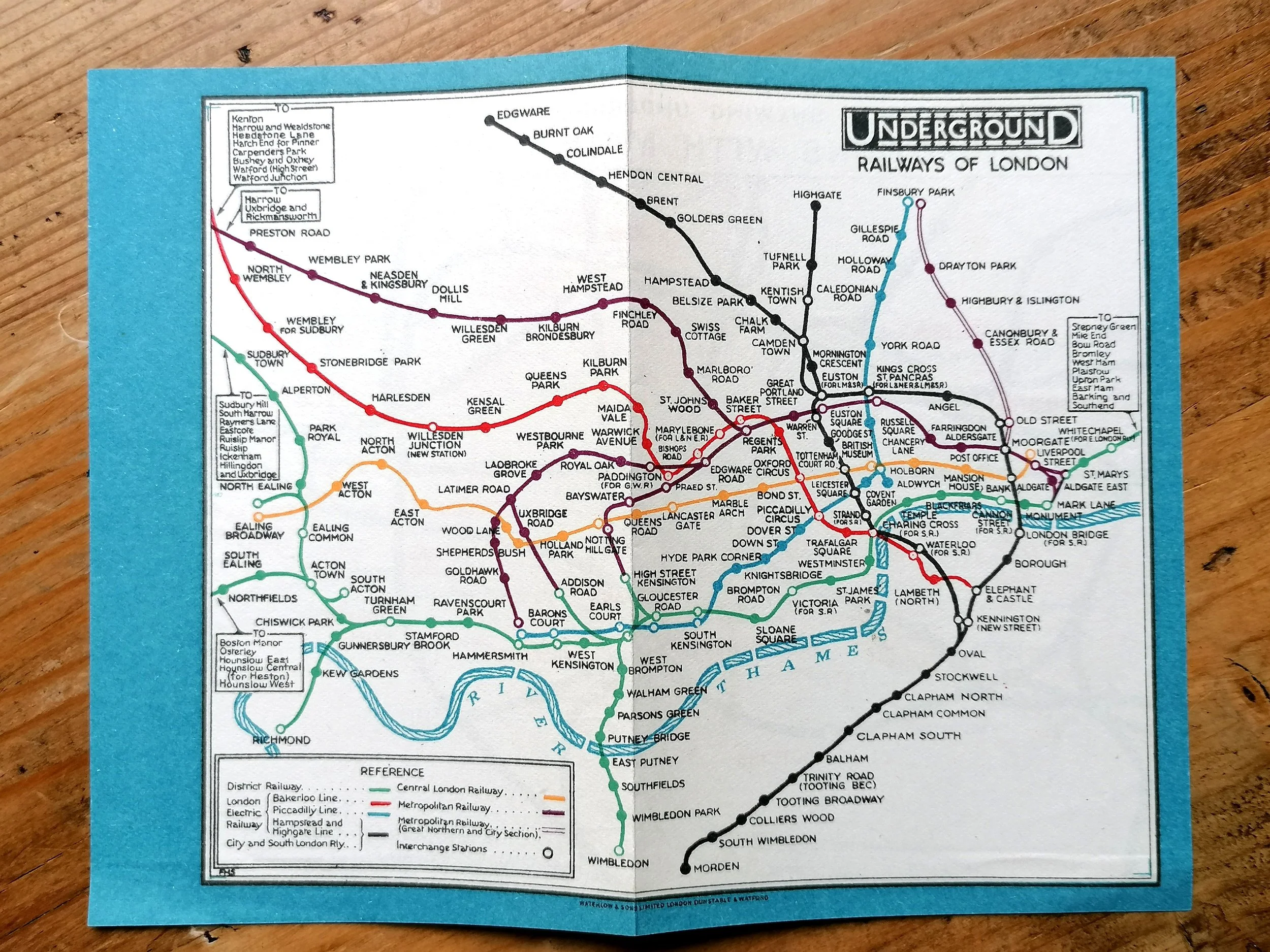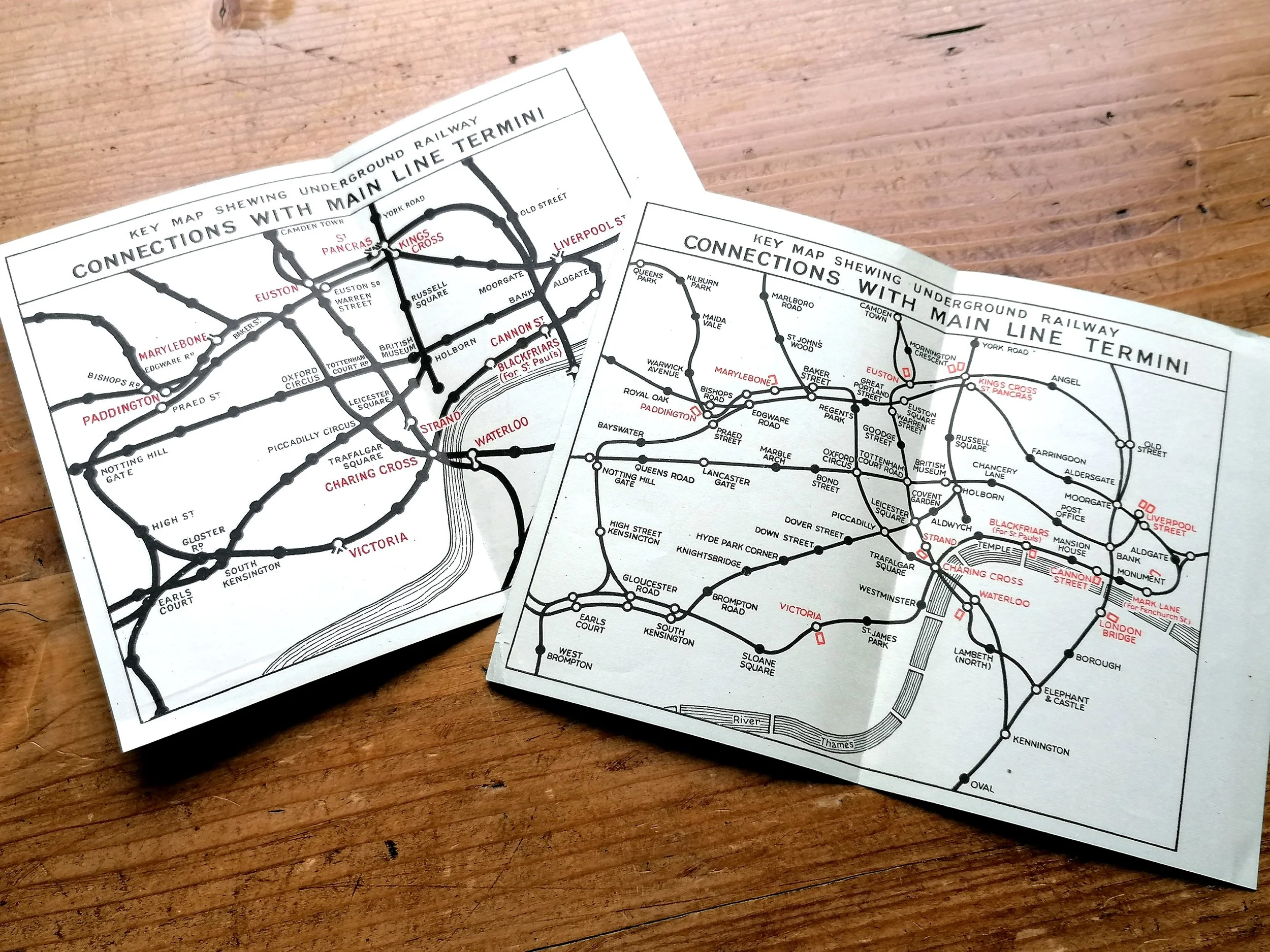 Image 1 of 4
Image 1 of 4

 Image 2 of 4
Image 2 of 4

 Image 3 of 4
Image 3 of 4

 Image 4 of 4
Image 4 of 4





1928 + 1930 London Underground Maps - Paper Editions - FH Stingemore
Underground Railways of London
Designed by FH Stingemore. Printed by Waterlow & Sons Ltd for London Underground. Colour lithograph on paper. Folded once as issued. Connections with Mainline Termini map on verso. Measures 167mm x 142mm.
In addition to the colourful array of ‘gatefold’ pocket maps (12 issues; 1925-1932), the Fred Stingemore Underground map was also printed in paper format in 1928 and 1930. These issues were produced exclusively for guide books (presumable because the thick linen-based card didn’t sit well within the pages). The map designs align to their card counterparts making them easy to date. The earlier map no longer has the mainline railway companies in brackets alongside mainline station names (1928 onwards). Yet it hasn’t seen the station names colour-coded to match the lines they serve (from 1929). The later map has both Piccadilly Line extension labels (red boxes) matching the first map issued in 1930.
Despite a career spanning over 40 years in the London Underground Drawing Office, it is as HC Beck’s immediate predecessor as map designer that Frederick Stingemore is most well known.
Like many before him, Stingemore grappled with the density and sprawl of the Underground railway network to draft a series of pocket maps from 1925 to 1932. The Stingemore series of pocket maps saw 12 bi-fold linen-card editions, each with a distinctive colour cover. The map design improved in clarity with each iteration whilst remaining topographical in format with some distortion applied for outlying areas. It was Stingemore that had encouraged his colleague, Harry Beck, to resubmit his radical circuit diagram design after it was initially rejected. Beck’s diagram was published in January 1933.
Underground Railways of London
Designed by FH Stingemore. Printed by Waterlow & Sons Ltd for London Underground. Colour lithograph on paper. Folded once as issued. Connections with Mainline Termini map on verso. Measures 167mm x 142mm.
In addition to the colourful array of ‘gatefold’ pocket maps (12 issues; 1925-1932), the Fred Stingemore Underground map was also printed in paper format in 1928 and 1930. These issues were produced exclusively for guide books (presumable because the thick linen-based card didn’t sit well within the pages). The map designs align to their card counterparts making them easy to date. The earlier map no longer has the mainline railway companies in brackets alongside mainline station names (1928 onwards). Yet it hasn’t seen the station names colour-coded to match the lines they serve (from 1929). The later map has both Piccadilly Line extension labels (red boxes) matching the first map issued in 1930.
Despite a career spanning over 40 years in the London Underground Drawing Office, it is as HC Beck’s immediate predecessor as map designer that Frederick Stingemore is most well known.
Like many before him, Stingemore grappled with the density and sprawl of the Underground railway network to draft a series of pocket maps from 1925 to 1932. The Stingemore series of pocket maps saw 12 bi-fold linen-card editions, each with a distinctive colour cover. The map design improved in clarity with each iteration whilst remaining topographical in format with some distortion applied for outlying areas. It was Stingemore that had encouraged his colleague, Harry Beck, to resubmit his radical circuit diagram design after it was initially rejected. Beck’s diagram was published in January 1933.
